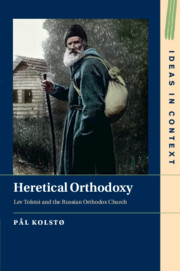Book contents
- Heretical Orthodoxy
- Ideas in Context
- Heretical Orthodoxy
- Copyright page
- Contents
- Preface
- Chapter 1 Introduction
- Chapter 2 Tolstoi as a Practicing Orthodox
- Chapter 3 Tolstoi’s Examination of Dogmatic Theology
- Chapter 4 Tolstoi, Orthodoxy and Asceticism
- Chapter 5 Lev Tolstoi and Orthodox Forms of Spirituality: Elders
- Chapter 6 Tolstoi and the Wanderer Tradition in Russian Culture
- Chapter 7 Tolstoi and the Ideal of “the Holy Fool”
- Chapter 8 Father Sergius: Kasatskii’s Spiritual Journey to Holy Foolishness
- Chapter 9 Tolstoi and the Social Ideal of the Eastern Church: John Chrysostom
- Chapter 10 The Church Mounts a Counterattack: Threat Perceptions and Combat Strategies
- Chapter 11 Between “Almost Orthodox” and “Antichrist”: Images of Lev Tolstoi in Russian Orthodox Polemics
- Chapter 12 The “Excommunication” and Its Aftermath
- Chapter 13 A Requiem for a Heretic? The Controversy over Lev Tolstoi’s Burial
- Chapter 14 Summary and Conclusions
- Bibliography
- Index
Chapter 13 - A Requiem for a Heretic? The Controversy over Lev Tolstoi’s Burial
Published online by Cambridge University Press: 15 September 2022
- Heretical Orthodoxy
- Ideas in Context
- Heretical Orthodoxy
- Copyright page
- Contents
- Preface
- Chapter 1 Introduction
- Chapter 2 Tolstoi as a Practicing Orthodox
- Chapter 3 Tolstoi’s Examination of Dogmatic Theology
- Chapter 4 Tolstoi, Orthodoxy and Asceticism
- Chapter 5 Lev Tolstoi and Orthodox Forms of Spirituality: Elders
- Chapter 6 Tolstoi and the Wanderer Tradition in Russian Culture
- Chapter 7 Tolstoi and the Ideal of “the Holy Fool”
- Chapter 8 Father Sergius: Kasatskii’s Spiritual Journey to Holy Foolishness
- Chapter 9 Tolstoi and the Social Ideal of the Eastern Church: John Chrysostom
- Chapter 10 The Church Mounts a Counterattack: Threat Perceptions and Combat Strategies
- Chapter 11 Between “Almost Orthodox” and “Antichrist”: Images of Lev Tolstoi in Russian Orthodox Polemics
- Chapter 12 The “Excommunication” and Its Aftermath
- Chapter 13 A Requiem for a Heretic? The Controversy over Lev Tolstoi’s Burial
- Chapter 14 Summary and Conclusions
- Bibliography
- Index
Summary
The final chapter in the saga of the Russian Church and its relationship to Tolstoi came with the prolonged polemics over his burial in 1910. This controversy started immediately after the promulgation of the Circular Letter, which laid down a ban on burial with Church rites. The chapter contains a wealth of new material: Probably the most important concerns the solution eventually agreed by the Church leadership in an attempt to extricate itself from the predicament in which it had placed itself with the requiem ban: While Tolstoi was drawing his last breath at the Astapovo railway station, the prelates finally decided to grant him burial in consecrated soil – with non-Orthodox, non-confessional but still Christian rites. However, this decision was not put into effect, or published, due to opposition from Tolstoi’s family. In that way, Tolstoi’s wish not to have any priests at the graveside during the burial was respected. However, the story did not end here, as an anonymous priest three years after his death turned up at Iasnaia Poliana and asked permission from the widow, Sof’ia Andreeva, to perform a requiem at the grave. When this was granted and became public, a new round of polemics ensued.
Keywords
- Type
- Chapter
- Information
- Heretical OrthodoxyLev Tolstoi and the Russian Orthodox Church, pp. 245 - 264Publisher: Cambridge University PressPrint publication year: 2022



